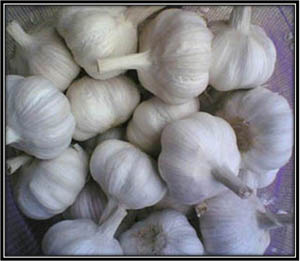ALLIUM SATIVUM
 Allium Sativum is the botanical name for garlic. This is also known by names like, ‘Lasan’ in Hindi and ‘Lasuna’ and ‘Rasonam’ in Sanskrit.
Allium Sativum is the botanical name for garlic. This is also known by names like, ‘Lasan’ in Hindi and ‘Lasuna’ and ‘Rasonam’ in Sanskrit.
In ancient Sanskrit scriptures, mention of garlic as a part of medicinal remedies dates back to 5,000 years. The Holy Bible mentions garlic as a common food in Egypt. Ancient Egyptian medicine dating back to 1550 BC also mentions this herb.
Athletes in early Olympic Games ate garlic before competitions to muster strength while soldiers from Greek army ate it before engaging in battles. It was used as first-aid in battlefields to avert infection in wounds.
CHARACTERISTICS OF ALLIUM SATIVUM
Our ancestors generated many species of garlic by cultivating it in different climatic and soil conditions and cultivation methods. This perennial, hardy plant is native to Central Asia but grows the world-over.
It requires fertile soil and warm climate for good growth up to 30-60 cms. The underground bulbs have a strong, pungent smell when crushed and have grass-like leaves above the ground. The bulb is widely used in many preparations of traditional medicine.
THERAPEUTIC USE OF ALLIUM SATIVUM
Ayurvedic medicine used garlic as an overall health stimulant rather than relieve for diseases and for its effectiveness in improving health of digestive, nervous, circulatory, respiratory, and reproductive systems.
SOME THERAPEUTIC EFFECTS OF ALLIUM SATIVUM ARE:
- Unani medicine uses garlic to relieve intestinal infection, dysentery, arthritis, colic in children, and food poisoning.
- South-west Americans use garlic to relieve cough while Appalachians use it to relieve chest colds and pneumonia.
- In Thailand, people eat raw garlic to avert diarrhea caused by parasites. A decoction prepared using fresh bulb is ingested orally to relieve inflammation. Crushed bulb is used as a poultice.
- French use garlic to relieve arteriosclerosis, allergies, asthma, arthritis, bronchial disorders, incontinence, acne, liver diseases, hypertension and emphysema.
- In Yugoslavia, hot water extract of the bulb is used to relieve diabetes.
- West-Indians use bulb–extract to relieve hypertension. They apply extract on the abdomen to facilitate parturition.
- Africans use garlic as anti-bacterial agent to relieve boils, sore throats and infected wounds.
The essential oil from garlic is used as diuretic, antimicrobial, antispasmodic, emmenagogue and anti-asthmatic.
NUTRIENT COMPOSITION
Garlic has many components which contribute to its therapeutic effectiveness including:
- Sulphur compounds
- Glycosides
- Amino Acids
- Monoterpenoids
- Minerals
- Vitamins
- Flavones
- Peptides
CARE OF AILMENTS
Ancient practitioner, Hippocrates recommended garlic to relieve cancer, infections, leprosy and digestive disorders. Galen, an eminent physician from ancient Rome referred to this herb as ‘peasants relieve’.
Garlic is used to relieve various diseases like:
- Chest disorder: Garlic reduces fetidity in pulmonary gangrene and relieves tuberculosis. Administering a decoction made by boiling garlic in milk every day relieves tuberculosis and pneumonia.
- Asthma: Consuming a decoction containing garlic cloves in milk, honey and fenugreek syrup daily before bedtime reduces severity of asthmatic attacks.
- Digestive disorder: Crushed garlic cloves in milk or water relieve digestive disorders. It acts as anti-septic and relieves inflammations and infections of the intestines and stomach. It assists in waste elimination, stimulates peristalsis and secretion of digestive juices.
- High blood pressure: Consuming two to three capsules per day reduces blood pressure. Garlic eases spasm of small arteries, slows pulse rate and modifies heart-rhythm. It also relieves dizziness, gas formation, and shortness of breath.
- Rheumatism: Anti-inflammatory property makes it suitable to relieve arthritis and rheumatism.
- Heart attack: Garlic breaks up cholesterol in arteries, thereby preventing their hardening which can otherwise lead to heart attacks.
- Cancer: Garlic juice and extract retards cancer and tumors progress.
- Whooping cough: Consuming five drops of garlic juice two to three times a day relieves this condition.
- Blood disorders: Garlic removes toxins, stimulates blood circulation and revitalizes blood. It enhances flora in the intestine to prevent infection by harmful bacteria.
- Skin disorder: Acne, boils, pimples and spots are avoided by external application of garlic while internal consumption purifies blood. Consumption of three garlic capsules a day keeps skin infections at bay. It relieves ring-worm when rubbed externally.
- Wounds and ulcers: Garlic juice mixed with three parts of water cleanses wounds. Application of the juice on ulcers removes pus and pain.
- Diphtheria: Chewing garlic cloves relieves infected mucosal membrane, decreases temperature and provides relief.
- Others: Garlic juice relieves loss of sexual power, debility and impotency. It is recommended for older men suffering libido or nervous tensions.
SAFETY AND PRECAUTIONARY TIPS WHILE USING ALLIUM SATIVUM
Allium Sativum is regarded safe making it an extensively used ingredient in cooking. While moderation is beneficial, ingestion of its bulb-extract or essential oil may sometimes cause nausea, diarrhea, vomiting or heartburn.
PLANET AYURVEDA PRODUCTS THAT USE ALLIUM SATIVUM
Allium Sativum is found in the following Planet Ayurveda Products:
It is always advisable to consult a medical practitioner before consuming any of the herbs and herbal supplements. We at Planet Ayurveda prescribe medicines and herbal supplements based on the principles of Ayurveda. We use only vegetarian and natural ingredients to manufacture our products. And we proudly claim that we do not believe in testing our products on animals. You can choose a healthy lifestyle by opting for Planet Ayurveda products.


